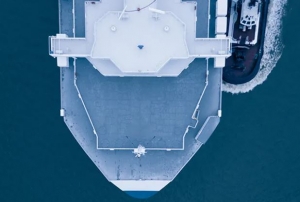


(Posted on 28/02/23)
A consortium including technology group Wärtsilä has secured European Union funding to develop solutions minimising methane slip from marine engines, advancing the environmental and climate benefits of LNG as a ship fuel.
Coordinated by VTT Technical Research Centre of Finland, the Green Ray project brings together several companies from across the shipping value chain: shipyard Chantiers de l’Atlantique, ship owner CMA CGA, classification society DNV, the Finnish Meteorological Institute, ship manager MSC Cruises Management, non-profit organisation Revolve Water and energy major Shell.
The project will develop on-engine technologies for low-pressure dual-fuel engines – both 2- and 4-stroke – as well as a novel aftertreatment concept. These solutions will be advanced to a high state of technology readiness, including demonstrators installed on two newbuilds and one retrofitted to an existing vessel. All the technologies developed in Green Ray will also be fully capable to utilize bio- or synthetic methane instead of fossil LNG.
Wärtsilä will develop technology specifically for low pressure 4-stroke dual fuel engines that enables methane slip reduction, increases efficiency and lower operational costs at all engine loads. This technology targets the largest four-stroke engines on the market as widely used by cruise ships, ferries and gas carriers.
Wärtsilä will also develop an on-engine technology for 2-stroke engines around a patented LNG injection system to reduce methane slip from tankers, container ships, etc. Both technologies will be demonstrated at sea in real application during the project in collaboration with the Green Ray partners.
The use of LNG as a marine fuel is accelerating, driven by a well-developed supply infrastructure, a clear transition to cleaner fuels and significant air pollution and climate benefits. The issue of methane slip – unutilized and thus unburned fuel escaping into the atmosphere from engines and across the production and supply chain – is seen as one of the main challenges to wider uptake.
“Methane slip has become an important factor in ship owners’ decisions about whether to use LNG fuel,” said Kati Lehtoranta, Principal Scientist, VTT. “ With these promising technologies we aim to reduce the slip contributing directly to reduction of the total greenhouse gas emissions, opening this pathway to even wider segment of the maritime market.”
Shell has developed a proprietary methane abatement catalyst system that has been lab tested and scaled up to a field demonstration, where it was proven to be effective not only in significantly reducing methane slip (over 90%), but also in handling typical compounds that can degrade the catalyst, via the inclusion of a guard bed.
“Shell’s climate ambition to become a net-zero emissions energy business by 2050 will require us to explore a range of avenues that have the potential to help us, our partners, and customers to decarbonise the existing LNG value chain. We are continuously working to improve the value proposition of LNG through dedicated technology research, and we are keen to develop potential solutions to minimise methane slip at such a relevant project as Green Ray,” explains Alexander Boekhorst, VP Gas Processing and Conversion Technology at Shell.
“This research will allow us to build on the continuous improvements made in reducing methane slip from engines over the past twenty years,” said Sebastiaan Bleuanus, General Manager, Research Coordination & Funding, Wärtsilä Marine Power. “Taking these solutions for newbuilds and retrofits to near commercial readiness will be an important step for the long-term viability of LNG as a marine fuel.”
The project has received funding of around €7 million from Horizon Europe. It will run until 2027.
Bruks Siwertell Group has announced a leadership transition as Peter Jonsson steps down as CEO after... Read more
ClassNK has issued an approval in principle (AiP) for a Rigid Windsail Type Wind-Assisted Propulsion... Read more
Elcome International’s new high-speed internet service, WELCOME, is revolutionising the way ship... Read more
Kaiko Systems, a leader in AI-driven frontline intelligence for the maritime industry, today announced... Read more
Marcegaglia’s latest acquisition, the LHM 600, marks a significant milestone as the 2,000th mobile... Read more
The Isle of Man Ship Registry (IOMSR) is playing a key role in the development of a high-tech sail aimed... Read more
AtoB@C Shipping, subsidiary of ESL Shipping, has taken delivery of Terramar in Goa, India on 14 March... Read more
As a new strategy period commences, VIKING Life-Saving Equipment A/S has achieved strong financial results... Read more
Baltic Exchange has introduced a series of green fuel options to its FuelEU voyage and compliance cost... Read more
Veson Nautical, a global leader in maritime data and freight management solutions, and Cargill have... Read more